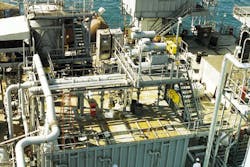First H 2 S oxidation process train installed offshore
Chevron USA Production Company selected the Lo-Cat II hydrogen sulfide oxidation process as part of the natural gas sweetening train for the Mobile Block 864-B production platform in the Gulf of Mexico. The entire sweetening train, consisting of both an amine unit and the Lo-Cat II unit, is located on the platform. The Lo-Cat II unit absorbs hydrogen sulfide from the amine acid stream and then converts it to elemental sulfur.
This was the first Lo-Cat II unit installed offshore. The unit is manufactured by US Filter. Several areas of the standard Lo-Cat II equipment package, including vessels, structural steel, and instrumentation, were redesigned so as to meet offshore requirements involving space, corrosion control, and onstream availability.
The existing platform had little space available for the unit. Therefore, space limitations required that the main processing vessel, the autocirculation vessel, be split into two vessels connected by tunnels. This in turn resulted in modification of the autocirculation vessel internals to allow for seal welding of the tunnels, eliminating any chance of leaks at the nominally bolt up connections between the vessels and the tunnels. To save additional space:
- The oxidizer air blowers were mounted on top of, rather than beside, the autocirculation vessel.
- The platforms around the settler vessel and the vacuum belt filter were consolidated.
- The standard shell and tube heat exchanger was replaced with a stab of heater mounted on top of the autocirculation vessel.
Chevron also required that after seal welding all vessels to the deck plate, that the deck plate beneath the vessel be removed. The autocirculation vessel, typically designed to be supported on a rigid foundation, was redesigned for this application so that the floor beams would both span the large open area and support the vessel.
Several instrument modifications including redundant level controls, modified level safety switches and modified temperature safety switches were required to meet the offshore availability requirements. The unit requires approximately 25 hours per week of operator attention. The modifications to the Lo-Cat II unit due to the offshore environment have not altered the expected performance of the unit.
In the process, the hydrogen sulfide is converted to innocuous, elemental sulfur by an environmentally safe, chelated iron catalyst in accordance with the following equation:
H2S + 1/2O2 H2O + S
The primary chemical consumptions are replacement of chelated iron lost in the sulfur removal process, replacement of chelating agents which oxidize over time, and a small caustic addition required to maintain the pH of the operating solution in the mildly alkaline range.
Copyright 1999 Oil & Gas Journal. All Rights Reserved.
